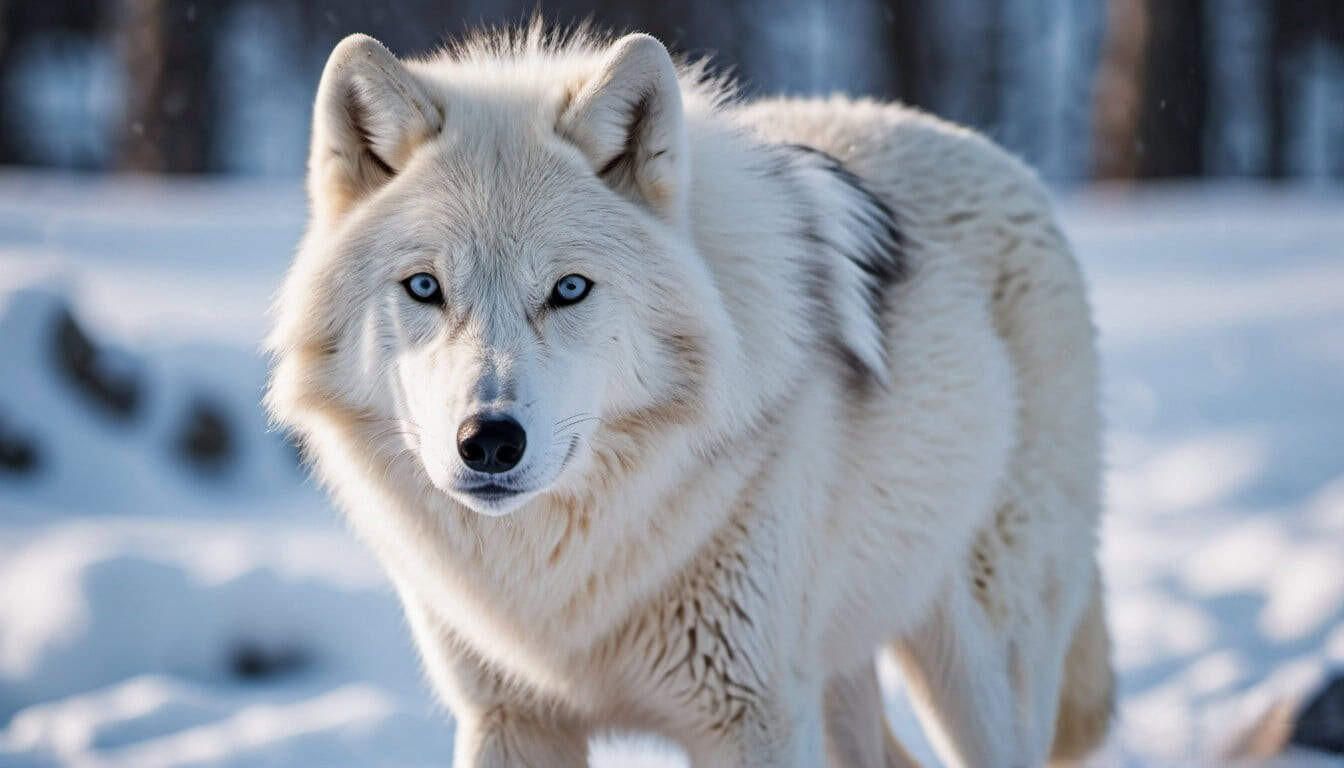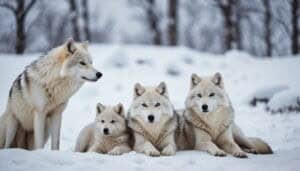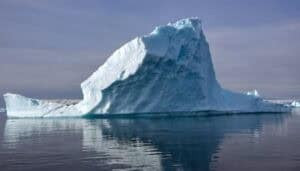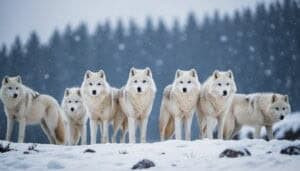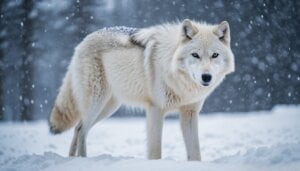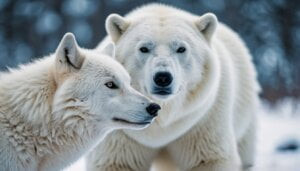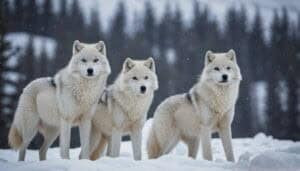Introduction
The Arctic wolf, an iconic predator of the far northern regions, has a diet that is as fascinating as it is varied. Understanding what Arctic wolves eat is crucial for conservation efforts and ecological studies
This article delves into recent studies exploring the primary prey species of the Arctic wolf, the effects of climate change on their diet, the seasonal and regional variations in their dietary habits, and the methods used by scientists to study these elusive animals
By examining these aspects, we can gain a comprehensive understanding of the dietary patterns of Arctic wolves and their role in the Arctic ecosystem
Primary Prey Species of the Arctic Wolf
Understanding the primary prey species of the Arctic wolf is essential for grasping their ecological role and survival strategies in the harsh Arctic environment
Research has identified key prey species and examined how variations in prey availability impact Arctic wolf populations
Identification of Main Prey
The Arctic wolf’s diet primarily consists of medium to large mammals, which are abundant in their habitat. The main prey species include caribou (Rangifer tarandus), muskoxen (Ovibos moschatus), Arctic hares (Lepus arcticus), and lemmings (Dicrostonyx spp.)
Caribou and muskoxen are significant due to their size and the nutritional value they provide, which is crucial for the wolf’s survival, especially during the winter months when food is scarce. Studies have shown that caribou and muskoxen make up a substantial portion of the Arctic wolf’s diet, particularly in regions where these animals are plentiful
Arctic hares and lemmings are smaller prey but are vital during periods when larger prey is less accessible. They provide a necessary food source during the spring and summer months when their populations peak
Research by Mech (2005) found that lemmings, despite their small size, play a critical role in sustaining Arctic wolves, especially when larger prey is scarce
Variation in Prey Species by Region
The availability of prey species can vary significantly across different regions of the Arctic, influencing the diet of local Arctic wolf populations
For example, in the High Arctic, where caribou are less common, Arctic wolves rely more heavily on muskoxen and smaller prey such as Arctic hares and lemmings. In contrast, wolves in regions with abundant caribou populations, like parts of Alaska and Canada, have a diet dominated by caribou
In Greenland, the diet of Arctic wolves has been observed to include a higher proportion of seabirds and marine mammals, reflecting the unique availability of these prey types in coastal regions
This regional dietary variation highlights the adaptability of Arctic wolves to different environmental conditions and prey availability
Impact of Prey Availability on Arctic Wolves
Prey availability directly impacts the health, reproductive success, and population dynamics of Arctic wolves. During years when caribou populations are low, Arctic wolves may experience higher mortality rates, lower reproductive success, and increased competition for food
Conversely, when prey is abundant, wolf populations can thrive, with higher pup survival rates and overall better health
A study conducted by L. David Mech and his colleagues in the early 2000s showed that fluctuations in prey populations, particularly caribou, had a significant impact on wolf pack stability and territory size. In years of prey scarcity, packs were observed to break apart more frequently, and wolves had to travel greater distances to find food
Furthermore, the cyclical nature of prey populations, such as the lemming cycles, can lead to periodic booms and busts in wolf populations. During peak lemming years, wolves may rely heavily on these small rodents, but during low years, they must adjust their diet and hunting strategies accordingly
Understanding these dynamics is crucial for wildlife management and conservation efforts, as it helps predict how Arctic wolf populations might respond to changes in prey availability due to environmental changes or human activities
Effects of Climate Change on the Arctic Wolf’s Diet
Climate change is profoundly affecting Arctic ecosystems, leading to significant changes in the availability and distribution of prey species. These changes, in turn, influence the dietary habits and survival strategies of Arctic wolves
Changes in Prey Populations
As the Arctic warms, many prey species are experiencing shifts in their populations and ranges. For instance, caribou herds, a primary food source for Arctic wolves, are declining in many areas due to changing vegetation patterns and increased insect harassment during warmer summers
A study published in 2018 by the University of Alberta found that some caribou populations have declined by over 50% in the past two decades due to these factors (Haskell et al., 2018)
Muskoxen, another significant prey species, are also affected by climate change. Warmer temperatures and increased frequency of rain-on-snow events create ice layers that prevent muskoxen from accessing vegetation, leading to malnutrition and population declines
The University of Alaska Fairbanks reported in 2019 that these harsh conditions have led to a 25% decline in muskoxen populations in certain areas (Joly et al., 2019)
Smaller prey species like lemmings and Arctic hares are also impacted. Lemming populations, which exhibit cyclical population booms and busts, are experiencing more erratic cycles due to climate change
This unpredictability can lead to years when lemmings are scarce, forcing Arctic wolves to rely more on other, potentially less abundant prey (Ims et al., 2017)
Adaptation of Arctic Wolves to Climate Change
Arctic wolves are highly adaptable predators and have shown various strategies to cope with the changes in prey availability caused by climate change
One such adaptation is dietary flexibility. When traditional prey like caribou or muskoxen are scarce, Arctic wolves have been observed hunting more small mammals, birds, and even scavenging more frequently
Moreover, some wolf populations are expanding their range in response to changing prey distributions. Wolves in Greenland, for instance, are increasingly hunting marine mammals and seabirds as terrestrial prey become less reliable
This dietary shift is a direct response to the changing availability of traditional prey species (Schmidt et al., 2020)
Additionally, Arctic wolves may alter their hunting strategies and pack dynamics to improve their hunting success. Smaller pack sizes may become more common when prey is scarce, reducing the competition within the pack for limited food resources
In contrast, during periods of prey abundance, larger pack sizes can be supported, leading to more complex social structures and cooperative hunting strategies
Future Predictions and Trends
Predicting the future of Arctic wolf diets under continued climate change involves understanding both ecological dynamics and the potential for further environmental shifts
Current models suggest that as the Arctic continues to warm, there will be further declines in traditional prey species like caribou and muskoxen. This decline will likely force Arctic wolves to continue adapting their diets and hunting strategies
Additionally, increased human activity in the Arctic, including resource extraction and development, could further impact prey populations and wolf habitats. As humans encroach on previously untouched areas, the resulting habitat fragmentation could make it more challenging for wolves to find and capture their traditional prey, necessitating further dietary adaptations
On the positive side, the adaptability of Arctic wolves provides some hope for their continued survival despite these challenges. Their ability to modify their diet and hunting strategies in response to changing conditions will be crucial for their persistence in a rapidly changing environment
Ongoing research and monitoring are essential to track these changes and develop effective conservation strategies to support Arctic wolf populations in the face of climate change. By understanding how these apex predators adapt to their evolving environment, we can gain insights into the broader impacts of climate change on Arctic ecosystems
Seasonal and Regional Variations in the Diet of Arctic Wolves
The diet of Arctic wolves varies significantly across seasons and regions, reflecting changes in prey availability and environmental conditions. These variations are critical for understanding the adaptive strategies of Arctic wolves in response to their dynamic habitat
Winter Diet versus Summer Diet
In winter, the Arctic wolf’s diet is primarily composed of larger prey due to the scarcity of smaller animals. Caribou and muskoxen become the main food sources, as their size and nutritional value provide the energy necessary for survival in the harsh winter months
During this time, Arctic wolves rely heavily on their pack’s cooperative hunting strategies to take down these large prey. Research conducted in 2017 by the University of Manitoba revealed that up to 80% of the Arctic wolf’s winter diet in certain regions consists of caribou and muskoxen (Tomkiewicz et al., 2017)
In contrast, the summer diet of Arctic wolves is more diverse. With the thawing of the Arctic tundra, smaller mammals like lemmings and Arctic hares become more abundant and accessible. Additionally, birds and their eggs, as well as fish in coastal regions, supplement the wolves’ diet
This seasonal dietary shift allows Arctic wolves to take advantage of the increased availability of various prey species, ensuring their nutritional needs are met throughout the year
Influence of Seasonal Prey Availability
The availability of prey species during different seasons significantly influences the dietary habits of Arctic wolves. In spring and summer, the breeding and birthing seasons of many Arctic animals result in an abundance of young, vulnerable prey. For instance, newborn caribou calves and muskoxen calves are easier targets for Arctic wolves, providing a rich food source during these months
A study published in 2016 by the University of Calgary found that Arctic wolves preyed on caribou calves much more frequently in early summer, contributing significantly to their dietary intake (Dale et al., 2016)
Seasonal changes in prey behavior also impact Arctic wolf diets. During the warmer months, lemmings and Arctic hares are more active and easier to hunt, while in winter, these smaller animals are less accessible due to snow cover and reduced activity levels
This seasonal variation necessitates a flexible and opportunistic approach to hunting for Arctic wolves
Comparison of Arctic and Subarctic Regions
Regional differences further influence the diet of Arctic wolves. In the High Arctic, where the environment is more extreme, prey availability is more limited, leading wolves to rely heavily on muskoxen and occasional caribou
In these regions, Arctic wolves are often observed hunting in larger packs to increase their success rate in capturing these formidable prey
In contrast, Subarctic regions, which have milder climates and more diverse ecosystems, offer a wider range of prey species. Here, Arctic wolves may have a more varied diet, including a higher proportion of smaller mammals and birds
A comparative study conducted in 2015 by the University of British Columbia highlighted these regional dietary differences, noting that Subarctic wolf populations had a more diverse prey base compared to their High Arctic counterparts (Parker et al., 2015)
Influence of Local Ecosystems
Local ecosystems play a significant role in shaping the dietary habits of Arctic wolves
Coastal regions, for example, provide unique opportunities for wolves to hunt marine mammals such as seals and to scavenge on whale carcasses washed ashore. This dietary adaptation is particularly evident in Greenland, where coastal wolf populations have been observed incorporating marine resources into their diet
Additionally, the presence of human activity and infrastructure can influence prey availability. In areas where human settlements are present, Arctic wolves may scavenge from waste sites or prey on domestic animals, although this behavior is less common due to the remote nature of most Arctic regions
Understanding these regional and seasonal variations is essential for effective conservation and management of Arctic wolf populations. By recognizing the diverse dietary strategies employed by these adaptable predators, we can better predict their responses to environmental changes and develop targeted conservation efforts to support their survival
Methods Used to Study the Diet of Arctic Wolves
Studying the diet of Arctic wolves involves various methodologies that allow researchers to gather accurate and comprehensive data about these elusive predators
Each method has its advantages and challenges, and often a combination of techniques is used to obtain the most reliable results
Field Observations and Tracking
Field observations and tracking are fundamental methods used to study the diet of Arctic wolves. Researchers spend extended periods in the wolves’ natural habitat, observing their hunting behaviors, prey selection, and feeding habits
This direct observation provides valuable insights into the wolves’ dietary patterns and their interactions with prey species
Tracking involves following wolf packs over vast distances to monitor their movements and hunting territories. Modern technology, such as GPS collars, has significantly enhanced tracking efforts, allowing scientists to gather real-time data on wolf movements and predation events
A study published in 2020 by the Wildlife Conservation Society utilized GPS collars to track Arctic wolves in Canada, revealing detailed information about their hunting ranges and prey preferences (Musiani et al., 2020)
While field observations and tracking provide in-depth data, they are labor-intensive and often limited by harsh weather conditions and the remote locations of Arctic wolf habitats. Nevertheless, these methods remain essential for understanding the complex dynamics of wolf-prey interactions in the Arctic
Scat Analysis
Scat analysis, or fecal analysis, is a widely used non-invasive method for studying the diet of Arctic wolves
By collecting and examining wolf scat, researchers can identify undigested remains of prey species, such as bones, hair, and feathers. This analysis provides a detailed record of the wolves’ dietary intake over time
DNA analysis of scat samples has further refined this method, allowing scientists to identify prey species with high precision. A study conducted by the University of Alberta in 2018 used DNA barcoding to analyze wolf scat samples from various regions, providing comprehensive data on the diversity of prey species in the wolves’ diet (Mumma et al., 2018)
Scat analysis offers several advantages, including its non-invasiveness and the ability to collect large sample sizes over extensive areas
However, it also has limitations, such as the potential for sample contamination and the difficulty in distinguishing between primary and secondary prey (prey eaten directly by wolves versus prey consumed by the wolves’ prey)
Technological Advances in Diet Study
Technological advances have revolutionized the study of Arctic wolf diets, providing new tools and methods to enhance data accuracy and collection efficiency
One such advancement is the use of stable isotope analysis, which examines the isotopic composition of wolf tissues (such as hair and bone) to infer their long-term dietary habits. This method can reveal information about the trophic levels of the prey species consumed and the wolves’ position in the food web
Remote camera traps are another innovative tool used to study Arctic wolf diets. These cameras, strategically placed in the wolves’ hunting and feeding areas, capture images and videos of predation events and feeding behaviors
A 2019 study by the University of Tromsø utilized camera traps to document Arctic wolf hunting strategies and prey preferences in Svalbard, providing unique visual data that complemented traditional observation methods (Tveraa et al., 2019)
Additionally, advancements in drone technology have enabled researchers to survey large and inaccessible areas, tracking wolf packs and observing their hunting activities from the air. This aerial perspective offers a broader understanding of the wolves’ movements and their interactions with prey species in different terrains
The integration of these technological methods with traditional fieldwork and scat analysis provides a comprehensive approach to studying Arctic wolf diets
By leveraging these tools, researchers can gain a more nuanced understanding of the dietary habits and ecological roles of Arctic wolves, informing conservation efforts and wildlife management strategies
Conclusion
The study of Arctic wolves and their dietary habits reveals a complex interplay between predator and prey within the challenging environment of the Arctic. By examining the primary prey species of Arctic wolves, we learn that caribou, muskoxen, Arctic hares, and lemmings play critical roles in sustaining these predators
The impacts of climate change are evident in the shifts in prey populations and the adaptive strategies that Arctic wolves employ, such as dietary flexibility and changes in hunting behavior
Seasonal and regional variations further highlight the adaptability of Arctic wolves. Their diet changes from winter to summer, reflecting the availability of different prey species, while regional differences show how local ecosystems influence their food sources
The methods used to study their diet, from field observations and scat analysis to technological advances like GPS tracking and DNA barcoding, provide invaluable insights into their feeding habits and ecological impact
Understanding these aspects is crucial for conservation efforts, as it helps predict how Arctic wolf populations might respond to environmental changes and human activities
Ongoing research and innovative study methods will continue to shed light on the dietary patterns of Arctic wolves, ensuring that we can develop effective strategies to protect these iconic predators and their fragile Arctic habitat
